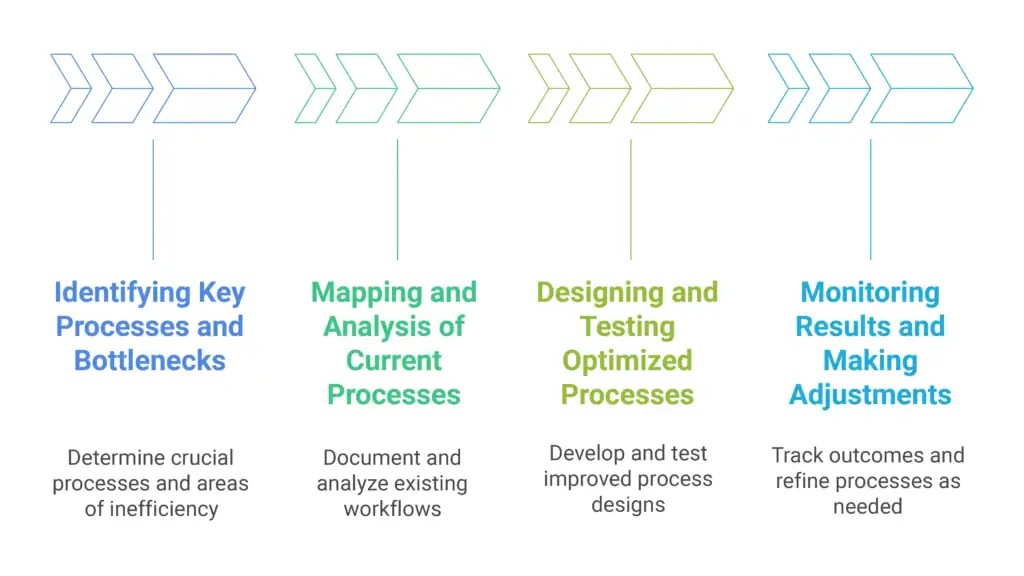Process optimization is a top priority for businesses operating in today’s fast-paced and highly competitive business environment. With costs continuing to increase, with a growing higher need for cost rationalization, better utilization of resources, and prompt response to market changes, businesses simply cannot afford wasteful processes or obsolescence. Process optimization is the process of reengineering, rationalization, and streamlining current business processes to eliminate bottlenecks, reduce wastage of resources, and facilitate smoother interdepartmental functioning. It is not cost reduction—it is designing flexible systems that allow scalability, innovation, and sustainable growth.
By using continuous improvement methods like Lean, Six Sigma, and business process management (BPM), organizations are able to methodically identify inefficiencies, align work efforts, and achieve goal realization at a quicker rate. The benefits far exceed productivity—streamlined processes mean improved customer satisfaction, faster decision-making, and increased employee satisfaction. Here, we will be covering process optimization methods that modern-day businesses can apply to rationalize processes, improve operational efficiency, and remain agile in an ever-changing market scenario.
Understanding Process Optimization in Business

Process optimization is a step-by-step process of improving business operations by using different process optimization techniques. It enables businesses to operate more effectively and efficiently. It includes the detection of errors, streamlining processes, and use of new ideas to improve productivity. All companies nowadays associate these improvements with online activities. Efficient processes are the strong foundations of successful operations.
Process optimization also involves the use of resources such as workflow automation, automation, and artificial intelligence. These technologies assist in minimizing human errors, enhancing quality, and supporting long-term development. The firms use these practices to ensure they compete favorably. They seek to make complicated systems easy and provide easy results on every front.
Definition and Key Objectives
Process optimization is about improving business processes intelligently. Many companies are trying to deal with inefficiency by replacing their old methods with ways in which to get their work done more quickly. They want to keep quality in the process.
The goal of process optimization is to enhance operational efficiency, lower costs, and improve product or service quality. Business process improvement increases operational efficiency, decreases waste, improves project management, increases teamwork and reduces turnaround time. So, process optimization leads to better workflows that lead to proper utilization of resources and increased performance overall.
Also, process optimization attempts to align processes with the organization’s objectives in a manner that allows for the maximum amount of flexibility, allowing businesses to adapt to shifting customer demands. Process optimization allows organizations to respond to changes in customer demand and contain their own costs to remain competitive within their industry. This methodology allows for continuous improvement and sustained success throughout every layer of the organization.
The Role of Process Optimization in Modern Businesses
In today’s fast-paced and competitive business world, business process optimization is extremely important. It helps companies with the ways and tools to fit in and reduce waste, so that every step they take contributes positively to their product or service.
The main purpose of process improvement is to align workflows with the value stream for faster and better delivery of services, while also generating a continuous development of innovation; it gives teams time and resources to focus on important changes.
In addition, companies that can optimize processes have a competitive advantage. They are still able to compete for quality, keep costs low and ensure satisfactory customer experience. By implementing optimized processes, a company can grow long-term quality, keep pace with industry standards and achieve better outcomes.
Core Benefits of Optimizing Business Processes

There are many great benefits to process optimization. First, it means businesses start doing things more efficiently. Teams can spend more effort on what’s truly important, can fix problems, and can reach peak performance. All of these changes can lead to speedier projects and increased productivity.
Additionally, eliminating costs and optimizing resources, through a better process, works by simplifying complicated processes. They also create higher-quality products and services. By making workflows smoother through reduction of delays and mistakes, organizations can keep things flowing, foster continual improvement, and reduce risks of non-compliance.
Enhanced Operational Efficiency and Productivity
Improving operational effectiveness is necessary for improving processes. When organizations redesign processes for operational efficiency and effectiveness, employees can focus their efforts on high-value work, rather than non-high-value work that is a waste of time and effort.
Process performance is better with effective processes. Effective processes create low-friction workflows that remove unnecessary roadblocks, eliminate hindrances, and ensure things happen more efficiently and effectively. Organizations that embrace effective processes perform faster find and meet their timelines for project completion. This way teams can actually fulfill the objectives they need to do in a timely fashion and as they are required.
Effective processes release the minds of workers and support a culture of growth. Workers have the opportunity to dismiss inefficiencies and see the world and how to actively improve workflows. All of this leads to positive growth to the business and helps develop a competitive advantage.
Cost Savings and Resource Management
Cost efficiencies arise from smart process improvement policies. As processes become streamlined, excessive unnecessary processes are removed, and human error is avoided. This results in less liability and spending.
Better resource management comes from operational optimization. Technology, including automation, allows companies to use their resources correctly. This means that labor and materials costs are reduced. Setting systems that allow them to ensure every asset they are using are having a positive impact for them.
Also, companies that continue to refine their processes have more financial leeway. Cost savings can be reinvested in meaningful projects. This fosters growth, innovation, and recurring profits.
Improved Quality of Products and Services
Process optimization enhances product quality and services significantly. Better workflows and strict quality control ensure accuracy and delivery at all times.
These streamlined procedures aim at minimizing errors and discrepancies, delivering high-quality goods or services that fulfill high industry expectations. This focus results in enhanced reliability and satisfaction, building confidence and goodwill among customers.
In the current market, quality matters a lot. Companies that enhance their processes gain a good reputation for providing excellent value. Through the improvement of their operations, businesses differentiate themselves, create long-term customer relationships, and remain competitive in their industries.
Strengthened Compliance and Risk Management
Being compliant with local laws and regulations is indeed one of the driving forces of a responsible modern business. Nonetheless, achieving compliance also involves the streamlining of processes, the latter being a significant factor to sustain that compliance. Efficient processes are mostly the ones that have steps that conform to the established legal and industry standards.
Furthermore, the revamping of business operations for the better also leads to the better control of risks. In other words, a combination of well-documented and automated processes is not only error-free but also more transparent and easily adjustable. Consequently, technology-reliant companies will not be exposed to any human factor-related dangers.
Besides, the business staying focused on being efficient and compliant gains the trust of the stakeholders. The market perspective, in turn, becomes considerably strengthened. On the one hand, process optimization gives the leaders an opportunity to improve their governance and reduce risks, thereby ensuring that the company is on a stable, long-term footing that can withstand market turmoil.
Strategic Methods to Achieve Process Optimization

Process optimization refers to the use of well-known techniques such as process improvement methodology that are fit for business needs. The lean management approach is maintained through continuous improvement.
Six Sigma is focused on removing defects and making performance reliable.
Utilizing technology like AI and automation also leads to more advanced outcomes. Robotic process automation and machine learning help in performance of repetitive tasks. This thus allows the companies to handle customer requests more quickly and perform their tasks more accurately. These mechanisms power the ongoing change and keep things in operation.
Lean Management Techniques
Lean management involves the reduction of waste and the development of customer-focused processes, while a business process reengineering approach is used. By eliminating useless steps and minimizing resource management companies apply total quality management, and they participate in a never-ending cycle of improvement.
Methods like value stream mapping and Just-in-Time manufacturing, are used to diagnose problems in organizations and to introduce new methods.
These methods not only help to promote an innovation culture, which generates a great deal of ideas from team members, but also encourage the development and continuous improvement of the latter.
Through matching lean practices with their business processes, companies can reduce lead times, use resources better and increase productivity. Companies that are pursuing high-quality operational performance should make use of lean management.
Utilizing Technology: Automation and AI
Technology is changing how we improve processes. It offers automation and AI tools that make work easier. Machine learning helps us use data better and predict results. Meanwhile, robotic process automation reduces manual labor.
| Technology | Key Benefits |
| Process Automation | Faster workflows, reduced errors |
| Machine Learning | Predictive insights, efficient processes |
| Robotic Process Automation | Streamlined task execution |
These tools help us make better decisions. They improve repeated tasks and lead to big gains in operational efficiency. Companies can better manage their inventory, support customers, and handle finances. This leads to high accuracy and lower costs.
Implementing Process Optimization: A Step-by-Step Guide

A clear approach makes processes better. Start by identifying key workflows and issues by mapping them out carefully and collaborating with others who are involved.
Once you have this map, start redesigning these processes to optimize them. Continue testing, observing, and tweaking what you do so that improvements stick. This way, optimizing will become a standard habit in your organization.
Identifying Key Processes and Bottlenecks
The first step in the process of the evaluation of present-day processes is recognizing critical processes. The companies’ workflows are the first point to consider. They must not only pinpoint any blockages but also document the actions that are not optimal via process mapping techniques.
Bottlenecking a process will slow an operation down. It makes the operations run slowly owing to the fact that it brings about delays, therefore, the work amount that is done within the period is at least. Despite not being easy, even the most obvious bottleneck can be demonstrated. They can be tracked by various means, including watching data and process mapping. Using such strategies, companies can find the right solution and correct them if needed.
It is of tremendous importance that the stakeholder’s root causes through an idea generation session and come up with a list of possible solutions. One essential way of doing so is working well together. Through which they can find the most convenient processes that suit them. This also helps to minimize the time it takes for some tasks to be handled and to prepare teams to tackle challenges in the future.
Mapping and Analysis of Current Processes
Process mapping in detail enables one to comprehend existing workflows just right. By demonstrating every step in a visual manner, firms are able to observe their dependencies and what could be hindering them.
Data gathering is important in the analysis. Measures assist in monitoring performance gaps, and this translates to actionable intelligence for improvement. Visualization tools also point out inefficiencies, and this assists in decision-making.
Analysis clarifies organizational processes. This clarity facilitates collaboration and inspires new ideas that are better aligned with the overall business objectives.
Designing and Testing Optimized Processes
One way to make workflows better is to change the way things are done so that they are efficient and accurate. The application of process improvement techniques facilitates the building of solid structures.
The procedures of testing are indeed one of the most important business success factors. The first step is to carry out a few small tests to see if the new workflows are really working. This also gives us the opportunity to handle any problems very early in the process through applying the data related to these tests.
When the involved processes have been verified through a test, they also match the set performance standards. As a result, the organization can be confident that after they are performing at their best they can move ahead with the better confirms that what comes next is visibly better outcomes work
Monitoring Results and Making Adjustments
Monitoring lean operations is monitoring the metrics that reflect the progress of the processes. Visualizations and the analysis let the company follow the event in the operations.
The changes are necessary steps in the process. The regular review of problems makes sure that in the future, the integration will be without any difficulties. By prediction of the results of the future, the enterprise can still be in the running for the improvement now made possible through analytics.
Both monitoring and adjusting are jointly used and become the basis of continuous progress. That is how the enterprises do not lose the adaptation and will always stay the frontrunner in the competition due to the market dynamics.
Conclusion
Process optimization, in conclusion, is not just a trend. It is a must for enterprises in this time of fast change for them to stay in the market. If, with the help of smart tactics having the right knowledge, and employing them effectively you manage to operate your ventures efficiently, you will likely grow to the best while using less cost and giving a higher quality of your goods or services to the final customer. Initiate your process optimization journey by identifying the principal ailments and evaluating your current processes. Lastly, create remedies with the right tools that are in line with your needs. Track your processes and adjust accordingly to the market developments. With the application of these methods, your business can prosper and become a place of dedication and efficiency. This will help your employees and satisfy your customers. In case you have any questions or doubts or you are still uncertain about the optimization process, you are free to visit our FAQ page or ask for help from our experts.
Frequently Asked Questions
How long does process optimization typically take?
The duration to optimize processes may vary depending on how complicated the project is and how prepared the organization is. Minor changes may take a few weeks. But large optimization projects may take months. Utilizing business process management systems can accelerate these changes. This enables companies to improve continuously within a shorter time.
What are common pitfalls in process optimization?
Common errors include omitting employee participation, focusing on unnecessary steps, and not accounting for resources required. These mistakes can result in inadequate outcomes. As you outline specific objectives and streamline processes, you have fewer mistakes. This contributes to a competitive advantage by streamlining processes efficiently.
What are some common process optimization strategies that businesses can implement?
Some of the popular methods include Lean management, process mapping, automation tools, and Six Sigma. These methods assist in developing effective processes, reducing waste, and fostering long-term competitive advantage. Best practices enable companies to experience steady growth and continue innovating.





